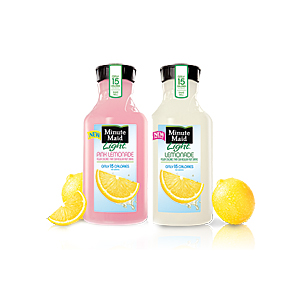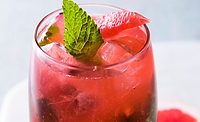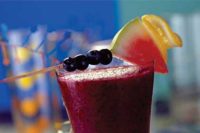Orange, lemon and lime were three of the top flavors used by beverage formulators last year, according to Beverage Industry’s 2012 New Product Development Survey. Nearly 50 percent of formulators used orange, followed by 39 percent who formulated with lemon and 29 percent who used lime. It’s not surprising then that the surveyed beverage-makers predicted orange, lemon and lime to be three of their best-selling flavors this year.

|
|
Featuring 15 calories in each 8-ounce serving, The Coca-Cola Co.’s Minute Maid brand launched Minute Maid Light Pink Lemonade. Ingredient companies note that juice drinks with reduced calorie content are a popular consumer trend that has impacted citrus. |
The juices and oils from citrus fruits are pleasant tasting and have been readily available on a large scale for flavoring food and beverage applications for many decades, which makes consumers around the globe very familiar with citrus flavors, says Steve Fowler, director of beverage applications for Kerry Ingredients & Flavours, Beloit, Wis.
“In many cases, citrus flavors such as orange, lemon and lime are seen as classic flavors — ones that consumers have seen in a variety of beverages and foods for many years,” says Teresa Polli, a senior manager of marketing communications with Kerry. “They are familiar with them and trust them.”
Citrus flavors also leave a taste in consumers’ mouths that keeps them wanting more, says Betty Honaker, Rocket Products Inc., Fenton, Mo. They also are lighter in appearance, she says. Douglas Rash, group vice president of global sales for Treatt USA, Lakeland, Fla., adds that citrus’s refreshing taste and positive health connotations continue to drive citrus forward in light of the ongoing trend for natural products. Citrus flavors also remain popular because they taste good in acidified beverages and with a range of ingredients, says Paulette Lanzoff, technical director at Synergy Flavors, Wauconda, Ill.
Although citrus flavors can stand alone in beverages, they also make excellent mixers, says Linda Lakind, senior marketing manager for beverages at Firmenich, Plainsboro, N.J. “Lemons, limes and oranges are all found in many combination flavors, so they blend very well with other flavors, whether it’s a berry or tropical,” she says.
Citrus’s familiarity to consumers, the heritage of citrus products in the United States, the versatility of citrus-based beverages for flavors, and citrus’s ability to tap into health and wellness trends continue to drive the popularity of the flavors, says Kristina McLaughlin, a global market research analyst for Kerry.
“Add to that the perception of citrus as a natural food/ingredient and its association with real fruit to help to keep citrus fruits in the forefront,” she says.
Citrus also remains a popular flavor category in new beverage introductions. “Year after year, we find that orange and lemon tend to hold the No. 1 and No. 2 positions, respectively, in terms of consumer consumption,” says Kim Carson, marketing manager for beverage at Givaudan Flavors, Cincinnati. “Other popular trends with citrus beverages include generic citrus or citrus plus berry or tropical flavors.”
Citrus expansion
Recently, flavor and nutritional content have created challenges for traditional juices, but this also is creating opportunities for juice drinks.
“We are seeing juice companies reinvent their core citrus beverages to compete with the functional waters that have a variety of flavors and functional ingredients but with low to no calories,” Kerry’s Polli says. “Another large area of concern for juice beverages revolves around sugar content. Consumers are moving away from full-sugar 100 percent juice beverages and toward more mid-calorie juice drinks that use no artificial sweeteners.”
Calorie reduction is at the heart of many beverage innovations, which also applies to citrus beverages. “Maintaining sugar sensations and mouthfeel in reduced-calorie or non-caloric citrus beverages is not an easy task,” Treatt’s Rash says.
The company particularly has seen an increased use of stevia in reduced-calorie citrus beverages. Treatt’s Treattsweet range can be used in citrus and other beverages as adjuncts to stevia to reduce some of the negative flavor connotations associated with the zero-calorie sweetener, Rash says.
Another current trend is to combine citrus with other popular beverage ingredients, such as tea. “Citrus with tea is a particularly strong trend,” Rash says. “These citrus combinations are not limited to lemon, but are expanding into grapefruit, orange and lime.”
Beyond traditional citrus, Givaudan has seen the emergence of specialty citrus produce that consumers have started to have the opportunity to experience.
“Produce sections in supermarkets across the United States have begun to provide consumers the opportunity to experience new and unique types of citrus fruits,” Givaudan’s Carson says. “Examples include blood orange varieties, pummelo, kumquat and ugli fruit. This exposure is opening consumers’ minds and palates, enabling unique citrus flavor experiences. We predict that as consumers continue to experiment and their palates evolve, there will be a need for unique citrus varietals in beverages that provide signature, authentic and exotic taste experiences.”
As consumers experience the tastes of new and exotic citrus varieties, Synergy Flavors is increasingly asked for flavors to match these varieties such as calamansi, kumquat and ortanique. Another popular request is for specific citrus varietals such as Sicilian lemon, Valencia orange and Kaffir lime.
“For most of these varieties, there are no essential oils to base the flavor upon,” Synergy Flavors’ Lanzoff says. “The flavor chemist will use a common base oil modified by other flavor components to create a unique profile similar to the fruit.”
Offering customers the ability to tailor authentic flavor profiles, Holzminden, Germany-based Symrise AG’s Naturally Citrus! brand features its Uniquely Yours platform using optimized and proven technologies such as MC, Symtrap and Spray Bed Drying, the company says.
With the growing Hispanic population in the United States, citrus’s popularity also continues to grow. “You see a lot more lime, but also tangerine,” Firmenich’s Lakind says. “Some of the products that are targeting that market also are featuring a little bit different nuisances in citrus.”
An ongoing trend in citrus is natural, according to experts. At Kerry, 95 percent of its Natural Products Division projects have had a natural requirement, either From the Named Fruit (FTNF) or With Other Natural Flavors (WONF), says Scot Benn, the company’s director of natural products research and development (R&D).
One of the primary functions of FTNF addback flavors is to restore reconstituted juice as close as possible to its original state, both from a technical and organoleptic standpoint.
“As analytical equipment becomes more sophisticated, flavor developers gain more insight into the authentic blueprint of orange juice,” says Arthur Soudijn, marketing director at Florida Worldwide Citrus, Bradenton, Fla. “This level of detail creates more challenges from an R&D standpoint, but at the same time expands the realm of opportunities in creative flavor design. We must keep in mind that too much analytical data may hinder the creative aspect of flavor development whereby the art is lost and only the science remains.”
An increase in organic citrus requests also is occurring.
“Citrus oils are 100 percent natural, but may not be classified as organic,” Soudijn says. “This relates to the use of non-organic fertilization and pest control applications used in the field. As such, the supply of organic citrus oils is limited and makes development of an organic citrus flavor cost prohibitive. We are, however, seeing growth in the number of organic-related requests, both from our U.S. and European customers. The supply options for organic oils and concentrates are improving, but command a significant premium over their natural but non-organic-certified counterparts.”
Also addressing the request for organic citrus, Flavors From Florida, Bartow, Fla., offers OrganicSensations, a complete line of organic beverage systems to respond to the increasing demand from consumers for organic fruit beverages. The company aims to deliver beverage systems made from organic ingredients while maintaining taste profiles that consumers want.
Citrus’s popularity will continue to grow because it is starting to be leveraged in other non-traditional areas of the beverage industry, Givaudan’s Carson says.
“There has been a substantial increase in blending citrus with other types of flavors,” she says. “For example, look at the success of lemonade and tea over the last year or so. Other ways we see citrus flavors paired is with different berries or tropical flavors. Flavor profiles like strawberry lemonade, orange mango and pomegranate citrus will continue to gain favor with beverage consumers.”
Many of these multiple juice blends also are fortified with vitamins, Florida Worldwide Citrus’s Soudijn adds.
Kerry has developed new flavor delivery systems designed to add citrus flavors into a variety of beverage and food systems. “We have developed and continue to develop new emulsion technologies to support the growing use of citrus in a wide variety of applications from smoothies to alcohol beverages,” Fowler says.
Kerry also is using improvements in solid phase and liquid-liquid extraction technology to create citrus ingredients and flavors that are more stable in a large variety of beverages, Kerry’s Benn says.
Going forward, orange-derived beverages are expected to maintain a significant share of the market. “Orange is universally accepted as a natural, fresh and healthy beverage,” Florida Worldwide Citrus’s Soudijn says.
Treatt’s prediction for citrus is that the natural theme and citrus-tea combinations will continue to grow. Functional drinks with tea and citrus are very much in vogue, Rash says. With regard to the alcohol beverage market, citrus remains popular as well. Both beers and spirits flavored with citrus are gaining momentum, while alcohol-based citrus-tea combinations also are moving forward, he says.
Citrus flavors are making their way into more mixed drinks and also as a blend with spices and other unique profiles, driving opportunity for further innovation to deliver more premium flavors in citrus-based beverages.
“For example, we are seeing an emergence of fresh squeezed juice bars entering the market. As such, Kerry is helping customers bring new blends of ingredients, functionality and flavors to create exciting new combinations,” Kerry's McLaughlin says. “Because citrus flavors are popular and familiar to the consumer, they offer a great starting point for flavor innovation in beverages, and with Kerry's capabilities to develop integrated citrus flavor and taste solutions, customers can quickly capture these market opportunities.” BI


